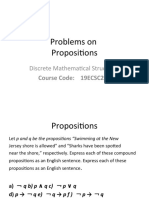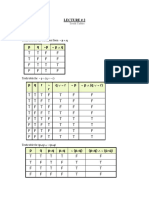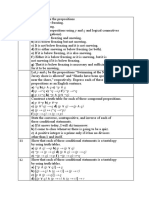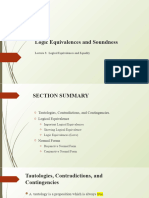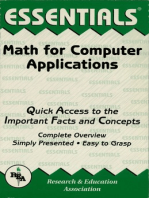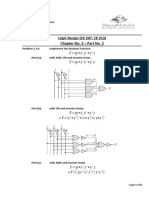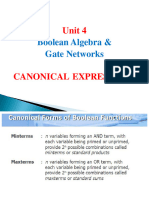Tutorial 1 - Logic Answers
Uploaded by
Aina AdrianaTutorial 1 - Logic Answers
Uploaded by
Aina AdrianaTUTORIAL 1 - Answers
DISCRETE STRUCTURE - SSK3003 GROUP 5
SEMESTER 1 2019/2020
1. Construct a truth table to prove that the following statements are logically
equivalent:
𝑝 → (𝑞 → 𝑟) ≡ (𝑝 ∧ 𝑞) → 𝑟
Answer:
p q r 𝒒 →𝒓 𝒑 → (𝒒 → 𝒓) (𝒑 ∧ 𝒒) 𝒑 → (𝒒 → 𝒓) ≡ (𝒑 ∧ 𝒒) → 𝒓
0 0 0 1 1 0 1
0 0 1 1 1 0 1
0 1 0 0 1 0 1
0 1 1 1 1 0 1
1 0 0 1 1 0 1
1 0 1 1 1 0 1
1 1 0 0 0 1 0
1 1 1 1 1 1 1
∴ 𝑝 → (𝑞 → 𝑟) is logically equivalent to (𝑝 ∧ 𝑞) → 𝑟
Prepared by: Dr. Normalia Samian
2. Construct a truth table for the following logical statement. State whether it is a
tautology or not.
[ (𝑝 ∨ 𝑞) ∧ (𝑝 ∨ 𝑟)] ↔ [ 𝑝 ∨ (𝑞 ∧ 𝑟)]
Answer:
p q r 𝒑∨𝒒 𝒑∨𝒓 (𝒑 ∨ 𝒒) ∧ (𝒑 ∨ 𝒓) 𝒒∧𝒓 𝒑 ∨ (𝒒 ∧ 𝒓) ↔
0 0 0 0 0 0 0 0 1
0 0 1 0 1 0 0 0 1
0 1 0 1 0 0 0 0 1
0 1 1 1 1 1 1 1 1
1 0 0 1 1 1 0 1 1
1 0 1 1 1 1 0 1 1
1 1 0 1 1 1 0 1 1
1 1 1 1 1 1 1 1 1
∴ [ (𝑝 ∨ 𝑞) ∧ (𝑝 ∨ 𝑟)] ↔ [ 𝑝 ∨ (𝑞 ∧ 𝑟)] is a tautology.
Prepared by: Dr. Normalia Samian
3. Given p = True, q = False, and r = True. Evaluate the following statement:
[ 𝑝 ∧ (𝑝 → 𝑞) ∧ 𝑟] → [(𝑝 ∨ 𝑞) → 𝑟]
Answer:
[ 𝑝 ∧ (𝑝 → 𝑞) ∧ 𝑟] → [(𝑝 ∨ 𝑞) → 𝑟]
= [ 𝑇 ∧ (𝑇 → 𝐹) ∧ 𝑇] → [(𝑇 ∨ 𝐹) → 𝑇]
= [ 𝑇 ∧ 𝐹 ∧ 𝑇] → [(𝑇 → 𝑇)] by implication and disjunction
=𝐹→𝑇 by implication and conjunction
=𝑇 by implication
Prepared by: Dr. Normalia Samian
4. Write the truth table for the proposition:
¬ (𝑟 → ¬ 𝑞) ∨ (𝑝 ∧ ¬ 𝑟)
Answer:
p q r ¬𝒒 ¬𝒓 (𝒓 → ¬ 𝒒) ¬ (𝒓 → ¬ 𝒒) (𝒑 ∧ ¬ 𝒓) ∨
T T T F F F T F T
T T F F T T F T T
T F T T F T F F F
T F F T T T F T T
F T T F F F T F T
F T F F T T F F F
F F T T F T F F F
F F F T T T F F F
Prepared by: Dr. Normalia Samian
5. By using logical equivalence, show that ¬ (𝑝 ∨ ¬𝑞) ≡ 𝑞 ∧ ¬𝑝.
Answer:
¬ (𝑝 ∨ ¬𝑞)
≡ ¬𝑝 ∧ ¬¬𝑞 De Morgan’s law
≡ ¬𝑝 ∧ 𝑞 Double negation law
≡ 𝑞 ∧ ¬𝑝 Commutative law
Prepared by: Dr. Normalia Samian
6. Simplify each of the following by using law of logic.
a) ¬(𝑝 ∨ 𝑞) ∨ (¬𝑝 ∧ 𝑞)
b) ¬(¬𝑝 → ¬𝑞)
Answer (a)
¬(𝑝 ∨ 𝑞) ∨ (¬𝑝 ∧ 𝑞)
= (¬𝑝 ∧ ¬𝑞) ∨ (¬𝑝 ∧ 𝑞) De Morgan’s Law
= ¬𝑝 ∧ (¬𝑞 ∨ 𝑞) Distributive Law
= ¬𝑝 ∧ 𝑇 Negation Law
= ¬𝑝 Identity Law
Answer (b)
¬(¬𝑝 → ¬𝑞)
= ¬(¬¬𝑝 ∨ ¬𝑞) from table
= ¬(𝑝 ∨ ¬𝑞) Double negation
= ¬𝑝 ∧ ¬¬𝑞 De Morgan
= ¬𝑝 ∧ 𝑞 Double negation
7. Using the truth table method, determine whether a given propositional logic is
a tautology, a contradiction or a contingency. Provide a precise justification for
your answer.
(p→q)→(p ∨(p →q))
Prepared by: Dr. Normalia Samian
Answer (b)
¬(¬𝑝 → ¬𝑞)
= ¬(¬¬𝑝 ∨ ¬𝑞) By Implication
= ¬(𝑝 ∨ ¬𝑞) Double negation
= ¬𝑝 ∧ ¬¬𝑞 De Morgan’s Law
= ¬𝑝 ∧ 𝑞 Double negation
Prepared by: Dr. Normalia Samian
Prepared by: Dr. Normalia Samian
You might also like
- Department of Computer Science, CUI Lahore Campus: CSC102 - Discrete Structures by Mahwish WaqasNo ratings yetDepartment of Computer Science, CUI Lahore Campus: CSC102 - Discrete Structures by Mahwish Waqas41 pages
- Assignment 1: Discrete Structure BS (CS) Propositional Logic 13th March 2022No ratings yetAssignment 1: Discrete Structure BS (CS) Propositional Logic 13th March 20221 page
- APznzaZZLu-Sw_quQP8UPR55lwAsCbg8jFZEoXffdJtbaQwIHcj-YcUM8B82puQxlbQ06BGA8ovFsEctcnnlmq_Z3xno5cE60-hVXqPKAGiD2vdo7_yOmXrr-eiExso6e0eoxto2wvCfzbEHk0BverjLv4A6sxuK0ZjU0Yc0y8DsdE-wqAnWzFohkMOMl_M6Nd8PbzwCROBWSjFP1_cUfQNo ratings yetAPznzaZZLu-Sw_quQP8UPR55lwAsCbg8jFZEoXffdJtbaQwIHcj-YcUM8B82puQxlbQ06BGA8ovFsEctcnnlmq_Z3xno5cE60-hVXqPKAGiD2vdo7_yOmXrr-eiExso6e0eoxto2wvCfzbEHk0BverjLv4A6sxuK0ZjU0Yc0y8DsdE-wqAnWzFohkMOMl_M6Nd8PbzwCROBWSjFP1_cUfQ2 pages
- Lecture Notes On Discrete Mathematics: Eusebius DoedelNo ratings yetLecture Notes On Discrete Mathematics: Eusebius Doedel357 pages
- 02 PropLogicPrfs-DNFCombined - Handout PDFNo ratings yet02 PropLogicPrfs-DNFCombined - Handout PDF4 pages
- Prove: (P Q) Q P Q: Proofs Using Logical EquivalencesNo ratings yetProve: (P Q) Q P Q: Proofs Using Logical Equivalences4 pages
- Section 1.2, Selected Answers Math 114 Discrete MathematicsNo ratings yetSection 1.2, Selected Answers Math 114 Discrete Mathematics2 pages
- w01 Tutorial Propositional Logic SolutionsNo ratings yetw01 Tutorial Propositional Logic Solutions7 pages
- JEE Main Mathematical Reasoning Previous Year Questions With SolutionsNo ratings yetJEE Main Mathematical Reasoning Previous Year Questions With Solutions6 pages
- Exercises-02_DM Unit-01 Set Theory & Logic_SY B.Tech CompNo ratings yetExercises-02_DM Unit-01 Set Theory & Logic_SY B.Tech Comp6 pages
- Constructing Truth Tables: General Mathematics ProgramNo ratings yetConstructing Truth Tables: General Mathematics Program24 pages
- HE151434 - Nguyen Thanh Lam - SE1616 - Homework1No ratings yetHE151434 - Nguyen Thanh Lam - SE1616 - Homework15 pages
- P: It Is Below Freezing. Q: It Is SnowingNo ratings yetP: It Is Below Freezing. Q: It Is Snowing2 pages
- Lecture 3 - Logic Equivalences and SoundnessNo ratings yetLecture 3 - Logic Equivalences and Soundness25 pages
- 2.3 - DE Unit 2 - 4variable - KMAP, Don't Care Conditions, QuineMc-Clusky MethodNo ratings yet2.3 - DE Unit 2 - 4variable - KMAP, Don't Care Conditions, QuineMc-Clusky Method34 pages
- Template Questions: Body Question Answers True Answer Mark TypeNo ratings yetTemplate Questions: Body Question Answers True Answer Mark Type7 pages
- Digital Logic & Design: Faraz Hasan KhanNo ratings yetDigital Logic & Design: Faraz Hasan Khan46 pages
- F Xy+x' y '+ y ' Z F Xy+x' y '+ y ' Z: Logic Design (CE 207, CE 213) Chapter No. 2 - Part No. 2No ratings yetF Xy+x' y '+ y ' Z F Xy+x' y '+ y ' Z: Logic Design (CE 207, CE 213) Chapter No. 2 - Part No. 28 pages
- Module 26 - Exercises On K-Map Simplification With Don't-Care ValuesNo ratings yetModule 26 - Exercises On K-Map Simplification With Don't-Care Values4 pages
- Cbse Xii Boolean Algebra 130206085155 Phpapp01100% (1)Cbse Xii Boolean Algebra 130206085155 Phpapp0157 pages
- 資工系王俊堯教授數位邏輯設計Unit 7_Multi-Level Gate Circuits NAND and NOR GatesNo ratings yet資工系王俊堯教授數位邏輯設計Unit 7_Multi-Level Gate Circuits NAND and NOR Gates25 pages
- Karnaugh Map - Don't Care Conditions - Tabulation Method: Simplification TechniquesNo ratings yetKarnaugh Map - Don't Care Conditions - Tabulation Method: Simplification Techniques31 pages
- Department of Computer Science, CUI Lahore Campus: CSC102 - Discrete Structures by Mahwish WaqasDepartment of Computer Science, CUI Lahore Campus: CSC102 - Discrete Structures by Mahwish Waqas
- Assignment 1: Discrete Structure BS (CS) Propositional Logic 13th March 2022Assignment 1: Discrete Structure BS (CS) Propositional Logic 13th March 2022
- APznzaZZLu-Sw_quQP8UPR55lwAsCbg8jFZEoXffdJtbaQwIHcj-YcUM8B82puQxlbQ06BGA8ovFsEctcnnlmq_Z3xno5cE60-hVXqPKAGiD2vdo7_yOmXrr-eiExso6e0eoxto2wvCfzbEHk0BverjLv4A6sxuK0ZjU0Yc0y8DsdE-wqAnWzFohkMOMl_M6Nd8PbzwCROBWSjFP1_cUfQAPznzaZZLu-Sw_quQP8UPR55lwAsCbg8jFZEoXffdJtbaQwIHcj-YcUM8B82puQxlbQ06BGA8ovFsEctcnnlmq_Z3xno5cE60-hVXqPKAGiD2vdo7_yOmXrr-eiExso6e0eoxto2wvCfzbEHk0BverjLv4A6sxuK0ZjU0Yc0y8DsdE-wqAnWzFohkMOMl_M6Nd8PbzwCROBWSjFP1_cUfQ
- Lecture Notes On Discrete Mathematics: Eusebius DoedelLecture Notes On Discrete Mathematics: Eusebius Doedel
- Prove: (P Q) Q P Q: Proofs Using Logical EquivalencesProve: (P Q) Q P Q: Proofs Using Logical Equivalences
- Section 1.2, Selected Answers Math 114 Discrete MathematicsSection 1.2, Selected Answers Math 114 Discrete Mathematics
- JEE Main Mathematical Reasoning Previous Year Questions With SolutionsJEE Main Mathematical Reasoning Previous Year Questions With Solutions
- Exercises-02_DM Unit-01 Set Theory & Logic_SY B.Tech CompExercises-02_DM Unit-01 Set Theory & Logic_SY B.Tech Comp
- Constructing Truth Tables: General Mathematics ProgramConstructing Truth Tables: General Mathematics Program
- A-level Maths Revision: Cheeky Revision ShortcutsFrom EverandA-level Maths Revision: Cheeky Revision Shortcuts
- 2.3 - DE Unit 2 - 4variable - KMAP, Don't Care Conditions, QuineMc-Clusky Method2.3 - DE Unit 2 - 4variable - KMAP, Don't Care Conditions, QuineMc-Clusky Method
- Template Questions: Body Question Answers True Answer Mark TypeTemplate Questions: Body Question Answers True Answer Mark Type
- F Xy+x' y '+ y ' Z F Xy+x' y '+ y ' Z: Logic Design (CE 207, CE 213) Chapter No. 2 - Part No. 2F Xy+x' y '+ y ' Z F Xy+x' y '+ y ' Z: Logic Design (CE 207, CE 213) Chapter No. 2 - Part No. 2
- Module 26 - Exercises On K-Map Simplification With Don't-Care ValuesModule 26 - Exercises On K-Map Simplification With Don't-Care Values
- 資工系王俊堯教授數位邏輯設計Unit 7_Multi-Level Gate Circuits NAND and NOR Gates資工系王俊堯教授數位邏輯設計Unit 7_Multi-Level Gate Circuits NAND and NOR Gates
- Karnaugh Map - Don't Care Conditions - Tabulation Method: Simplification TechniquesKarnaugh Map - Don't Care Conditions - Tabulation Method: Simplification Techniques

























